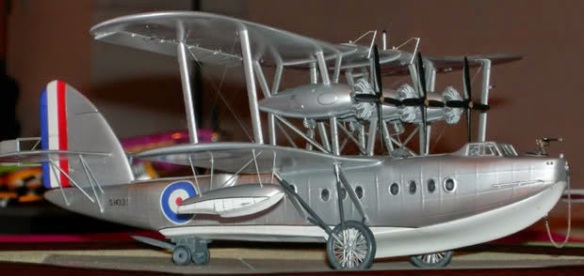
This 1/72 model is built by Ian Fountaine from the Contrail vacform kit. It was awarded Gold in its category (#9 – Military Aircraft 1/143 to 1/72 Vacform) at Scale Model World 2007
The Rangoon was a straightforward military adaption of the Calcutta. The major changes were the use of an enclosed cockpit for the pilots, the addition of three Lewis guns (one mounted forward of the cockpit and two in the fuselage behind the wings), the provision of enlarged fuel tanks in the upper wing, under-wing armament racks and a large fresh-water tank (specified for the intended use in tropical conditions). 6 aircraft were built from 1930 to 1933.
Operated by No. 203 Squadron RAF from Basra, Iraq. Rangoons provided useful service to the Royal Air Force, the French Navy and, (converted for civilian use), Imperial Airways. The last British Rangoon was taken out of service in 1938.
The Rangoon was a straightforward military adaption of the Calcutta. The major changes were the use of an enclosed cockpit for the pilots, the addition of three Lewis guns (one mounted forward of the cockpit and two in the fuselage behind the wings), the provision of enlarged fuel tanks in the upper wing, under-wing armament racks and a large fresh-water tank (specified for the intended use in tropical conditions).
The Rangoon was initially created as a military version of the Short S.8 Calcutta to meet Air Ministry Specification R.18/29 for a flying-boat for the Royal Air Force; this direct development was emphasised by the assignment of the version number S.8/8. The Royal Air Force needed urgent replacements to re-equip No. 203 Squadron RAF, operating out of Basra, and three aircraft were constructed, the first of which was flown on 24 September 1930 by Shorts’ Chief Test Pilot, John Lankester Parker. The three Rangoons were delivered to Basra in 1931[3]; over the next three years three more Rangoons (built to a higher specification R.19/31) were delivered to No. 203 Squadron RAF in Basra where they served without problem until they were replaced by Short Singapore IIIs in 1935.
In 1934 three Rangoons of No. 203 Squadron visited Australia as part of the Victoria Centenary celebrations.
No. 210 Squadron RAF at Pembroke Dock took delivery in August 1935 of the Rangoons returning from Basra, and when they left military service in 1936, one was converted for civilian use and flown by Imperial Airways for training purposes until its retirement.
Variants
Rangoon
Version produced by Shorts, 6 aircraft built.
Naval Calcutta
Version produced by Shorts (1 aircraft) and by Breguet (4 aircraft – Breguet 521-01 Bizerte).
K.F.1
Version built by Short Brothers who built 1 aircraft. Remaining 4 were built as the Kawanishi H3K by Kawanishi, Japan.
Specifications (Rangoon)
General characteristics
Crew: 5
Length: 66 ft 9½ in (20.36 m)
Wingspan: 93 ft (28.35 m)
Height: 23 ft 9 in (7.24 m)
Wing area: 1,828 sq ft (169.9 m)
Empty weight: 14,000 lb (6,360 kg)
Loaded weight: 22,500 lb (10,200 kg)
Powerplant: 3× Bristol Jupiter XIF, 540 hp (403 kW) each
Performance
Maximum speed: 100 knots (115 mph, 185 km/h)
Cruise speed: 83 knots (92 mph , 148 km/h)
Range: 565 nm (650 miles, 1046 km)
Service ceiling: 12,000 ft (5,500 m)
Rate of climb: 550 ft/min (2.8 m/s)
Endurance: 7 hrs at 92 mph
Armament
Guns: Three 0.303 in Lewis guns
Bombs: Up to 1,000 lb (455 kg) (bombs